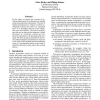Free Online Productivity Tools
i2Speak
i2Symbol
i2OCR
iTex2Img
iWeb2Print
iWeb2Shot
i2Type
iPdf2Split
iPdf2Merge
i2Bopomofo
i2Arabic
i2Style
i2Image
i2PDF
iLatex2Rtf
Sci2ools
LWA
2008
2008
Hybrid Personalization For Recommendations
In this paper we present the concept of hybrid personalization, the combination of multiple atomic personalization mechanisms. The idea of hybrid personalization is related to hybrid recommender systems, but works on a conceptual level--it is decoupled from the actual adaptation in the user interface. This has as an advantage that one can optimize the adaptation `behind the screens' or--conversely--attach a new visualization mechanism to the personalization technique. We show the practical benefits of this layered, hybrid adaptation mechanisms by means of a case study on personalized curriculum planning where it is recommended which course could or should be followed at which state in the learning process.
Atomic Personalization Mechanisms | Hybrid Adaptation Mechanisms | Hybrid Personalization | LWA 2008 | Software Engineering |
| Added | 29 Oct 2010 |
| Updated | 29 Oct 2010 |
| Type | Conference |
| Year | 2008 |
| Where | LWA |
| Authors | Eelco Herder, Philipp Kärger |
Comments (0)

